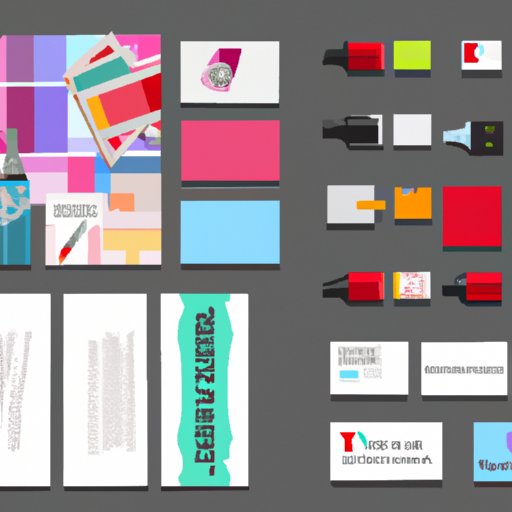
Introduction
Business cards are the perfect way to introduce yourself and your business to potential clients and partners. A well-designed and informative business card can make a great first impression and set you apart from the competition. It’s important to create a professional and memorable design that represents your brand and communicates your message effectively. In this article, we’ll explore the step-by-step process of creating business cards, share tips and tricks for design, discuss tools and materials needed, showcase examples of effective designs, and share personal experiences.
Step-by-Step Guide
The process of designing and printing business cards can be overwhelming, especially if you are creating them for the first time. Here’s a step-by-step guide to help you create professional-looking business cards:
Choose a Layout, Font, and Color Scheme
The first step in designing your business cards is choosing a layout, font, and color scheme. The layout should be simple and easy to read, with plenty of white space to make key information stand out. Choose a font that is legible and easy to read, and avoid using more than two or three fonts on your card. The color scheme should be consistent with your brand and reflect your business personality.
Include Important Information
The most important information to include on your business card is your name, job title, and contact information. Make sure your name and job title are prominently displayed, and include your email address, phone number, and website address. If you have social media profiles, you can include them as well.
Printing Process
When it comes to printing your business cards, there are a variety of options to choose from. You can print them yourself using a printer and cardstock paper, or order them from a printing company. If you choose to print them yourself, make sure you use a good quality printer and a thick paper stock. If you order them from a printing company, make sure you choose a reputable company that offers high-quality printing options.
Cutting and Trimming
After printing your cards, you’ll need to cut and trim them to size. Use a paper cutter or scissors to cut them down to the right dimensions, and make sure they are all of the same size and shape. To ensure a clean cut, place a piece of tape over the edge of the card where you want to cut.
Tips and Tricks
Creating a memorable and effective business card requires more than just following the basic design guidelines. Here are some insider tips and tricks to help you take your business card design to the next level:
Unconventional Shapes
Using an unconventional shape for your business card can make it stand out from the competition. Consider using a unique shape that reflects your brand, such as a rounded or circular card. However, if you’re going to use an unconventional shape, make sure it will fit in a standard card holder.
QR Codes
Another way to make your business card more interactive is to include a QR code that leads to your website or social media profiles. This adds an extra layer of functionality to your business card and encourages recipients to engage with your brand online.
Design for Different Industries
The design of your business card should reflect the industry you’re in. For example, if you’re in a creative field like graphic design, your card should be more playful and colorful. If you’re in a corporate setting, your card should be more professional and straightforward.
Showcase Examples
To help inspire your business card design, here are some examples of effective and memorable designs:
Minimalist Design
A minimalist design can create a clean, professional look. Black and white color scheme and sans-serif font can make this design really stand out.
Creative Shapes
This design features an unconventional shape to make it stand out, with the company logo prominently displayed in the center.
Interactive Design
This design features a QR code that leads to the company website, making it more interactive and engaging for recipients.
Tools and Materials
To create professional-looking business cards, you’ll need the right tools and materials. Here are some recommendations:
Design Software
Some popular design software for creating business cards include Adobe InDesign, Canva, and Microsoft Word. Canva is the most user-friendly and affordable option, especially for beginners.
Printer
When it comes to printers, there are a variety of options to choose from. An affordable and high-quality option is the HP OfficeJet Pro 9025, which offers fast printing speeds and high-quality prints.
Paper Types
The best paper types for business cards are a thick cardstock paper with a gloss or matte finish. Some popular options include Mohawk Superfine Eggshell, Neenah Classic Crest Solar White, and French Paper Co. Speckletone.
Personal Experiences
Creating business cards can be a challenging and rewarding experience. Here are some personal experiences shared by business owners:
“I spent hours designing my business cards, and it paid off. People always ask me where I got them printed because they look so professional.” – John, Graphic Designer
“I wanted my business cards to be memorable, so I decided to go with a unique shape. It ended up being a great conversation starter at networking events.” – Sarah, Marketing Consultant
“My business card design has evolved over time. I’ve learned what works and what doesn’t, and I’m always looking for ways to improve the design.” – Tim, Freelance Writer
Conclusion
Creating effective business cards takes time and effort, but it’s worth it to make a great first impression with potential clients and partners. Follow our step-by-step guide, use our tips and tricks, and showcase examples to create a professional and memorable design that reflects your brand. Remember to use the right tools and materials, and learn from personal experiences to continually improve your design. Get started on your own design today and set yourself apart from the competition.




